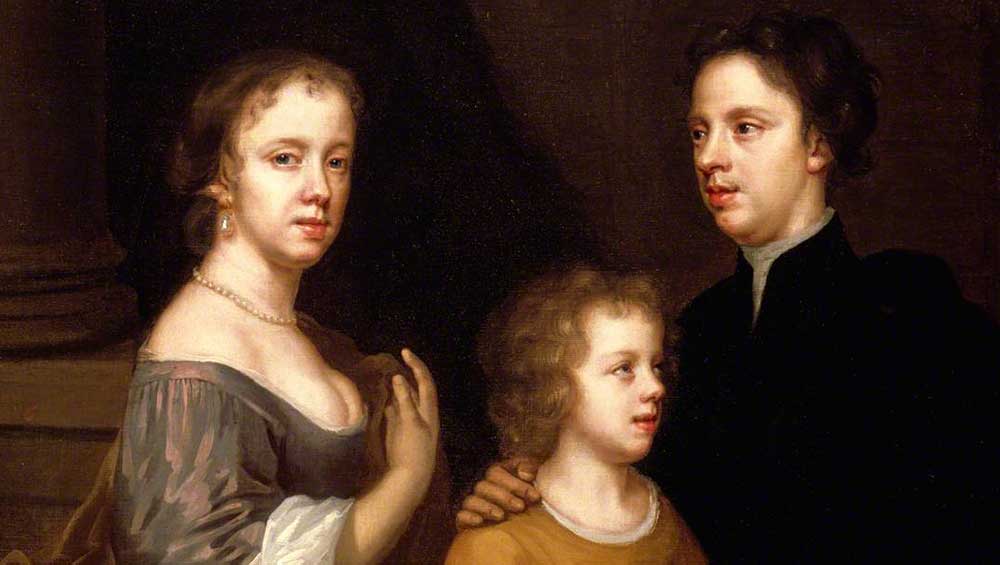
Mary Beale. Self Portrait of Mary Beale with Her Husband and Son, late 1650s (detail). Museum of the Home.
Philip Mould & Co, London
25 April – 19 July 2024
by ANNA McNAY
Have you ever heard of the painter Mary Beale (1633-99)? No? Well, neither had I until I received information on this exhibition comprising 24 of her portrait paintings at Philip Mould & Co. And then, as is always the way, I came across her everywhere, including in books I was reading about female artists and in Tate Britain’s landmark exhibition, Now You See Us: Women Artists in Britain (1520-1920), where she is billed as “the best known and most prolific” of the female artists who worked in Britain in the 17th century.1 In fact, she is often credited as Britain’s first professional female artist. It is in this role that Mould wants to show Beale in this academic (non-commercial) exhibition: yes, she was a wife and, yes, she was a mother, but, first and foremost, she was a professional artist and the breadwinner in her family.
Accordingly, the first picture you see, as you descend into the gallery’s basement (on show upstairs is Jonathan Yeo’s controversial portrait of King Charles III), is Self-Portrait with Husband and Son (late 1650s), Beale’s earliest recorded self-portrait (and purportedly the earliest self-portrait in British art history to include the depiction of a husband), and one which Mould refers to as a “manifesto portrait” – that is, like something of a business card. Her awareness of the importance of self-promotion is evident, as is the deliberate crafting of her artistic reputation. Her pose, for example, looking over her shoulder and directly out at the viewers while her husband and son look to either side, echoes the stance of Van Dyck, while the inwardly directed hand gesture was one often employed by Albrecht Dürer. By using such recognisable art historical signifiers, Beale places herself within a well-established – and respected – tradition of self-portraiture.2 Nevertheless, she is still dressed as a genteel lady, preserving all other aspects of her reputation.
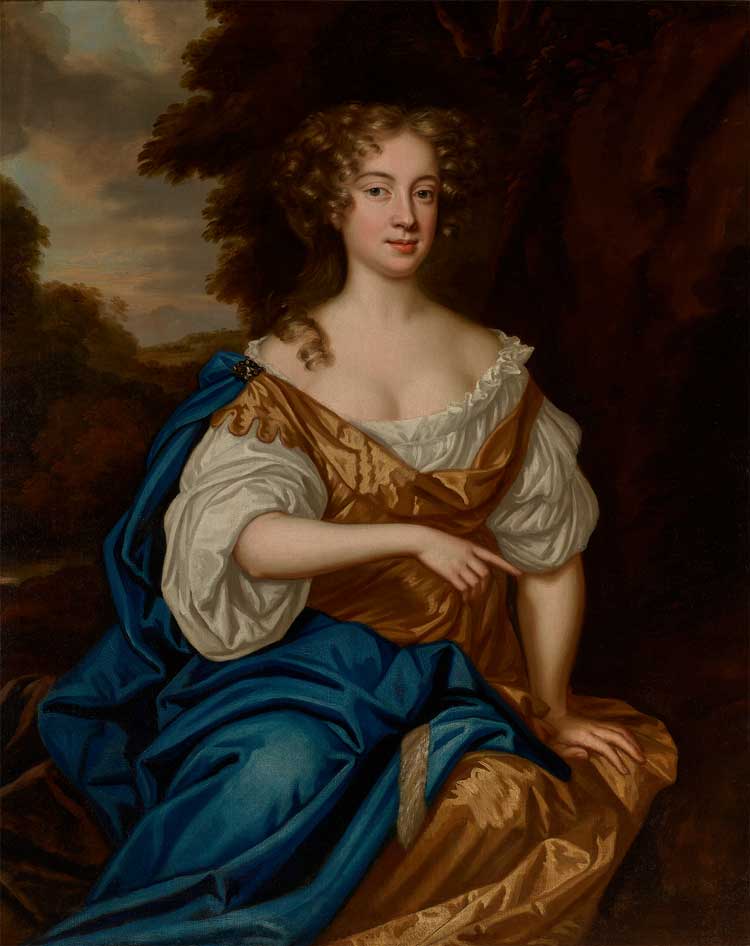
Mary Beale. Portrait of Anne Sotheby (née Robinson) (1657-1727), 1677. Oil on canvas, 50 x 41 in (127 x 104.2 cm). Philip Mould & Company.
Other works in this first room are primarily examples of commissioned portraits. Portrait of Anne Sotheby (née Robinson) (1676) was recently acquired by Tate, and the real painting is on show in Now You See Us; here we can see a (very convincing) printed copy. It exemplifies the so-called “half-length” – one of three formats of single-figure portraits with which Beale worked – depicting the sitter from head to knee. The cheapest and most popular format was the “three-quarters”, which comprised the head and upper torso, cut off at the elbows and set against a plain background, possibly with some trompe l’oeil stonework or fruit, while the third was the full-length portrait, rare among Beale’s known works, but illustrated here by her likeness of the politician, philanthropist and Lord Mayor of London, Sir William Turner (1676), shown in his long mayoral robes and gold chain of office.
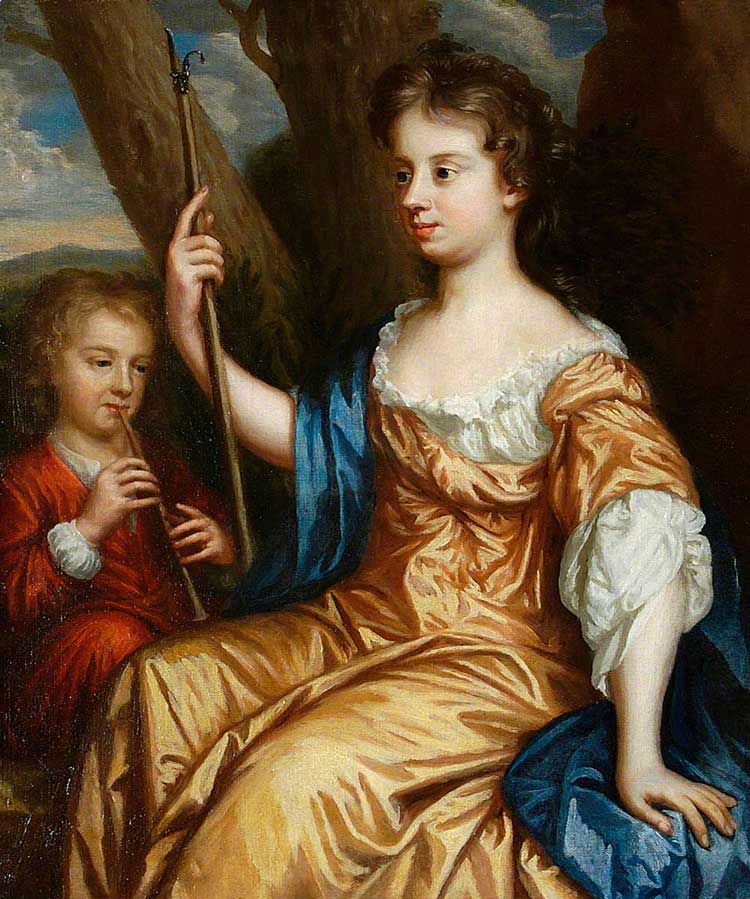
Mary Beale. Self Portrait as a Shepherd. Oil on canvas, 21 x 18 in (53.3 x 45.7 cm). Moyses Hall Museum, West Suffolk Heritage Service. © Purchased with the aid of a grant from the Heritage Lottery Fund. On loan from Moyse’s Hall Museum, West Suffolk Council Heritage Service.
The composition for the portrait of Sotheby is a near exact copy of one by the King’s portraitist of the day, Sir Peter Lely, of Elizabeth Stanley (née Butler), Countess of Derby (mid 1670s), and the use of an idyllic landscape as the backdrop was also a style he had popularised (and one which Beale further used to effect in Self-Portrait as a Shepherdess (mid-1660s), thus aligning herself with Lely’s fashionable and respected female sitters). Beale’s works were often misattributed as from the studio of Lely, but, while she was his neighbour for some years in Covent Garden in the mid-1650s, there is no evidence she was ever his pupil. On the contrary, the fact that she was later keen to take up his offer of watching him at work in the 1670s strongly suggests that she had not previously had this opportunity.3 She certainly studied his work and admired his style, however, imitating the postures of his figures and accepting commissions for copies of his original portraits. An example of a near-direct copy here is her slightly smaller portrait of King Charles II (c1675) (after Lely).
Lely and the Beales enjoyed a mutually beneficial relationship. The elder artist encouraged Mary, while accepting numerous commissions from her and her husband to paint their family and friends. A comparison of their earnings is testament to the level of success that Beale enjoyed: as the King’s painter, Lely received £200 a year; Beale earned just over £200 a year off her own bat. In the 1670s, Lely was charging £20 for a “three-quarters” and £30 for a “half-length” portrait compared with Beale’s fees of £5 and £10 respectively.4 Beale never became the King’s painter, instead walking a tightrope between the benefits of royal association and the risk to her reputation, personal and professional, that this might pose.5 Sealing her professional success in the 1660s, Beale’s name appeared in the London advertising periodical, A Collection for the Improvement of Husbandry and Trade, as an equal alongside leading male portrait painters of the time.6
While Beale’s father, John Cradock, was an amateur artist and member of the Company of Painters and Stainers, he doesn’t appear to have taught his daughter. In fact, we know nothing of her training, with most concluding she was largely self-taught. Of her professional life, however – from marrying Charles Beale, also an amateur artist, shortly after her father’s death when she was 19 – we have punctilious knowledge, thanks to the meticulous record-keeping by her husband, who gave up his own aspirations to become studio manager to Mary, also mixing her paints and preparing her canvases. For 30 years, he recorded her patrons and any monies exchanged, as well as her painting techniques and materials and colours used. He kept these almanacks in a popular brand of pocketbook diaries, of which two survive. They were described by the early-18th-century art historian George Vertue as: “Small Almanack pocketbooks – wherein he daily writ many affairs of business & family accounts &c. but the most remarkable is the daily imployments of his ingenious wife Mrs Beal concerning her painting & drawing from the life, or from famous paintings. He every day minutely mentions what she was imployd in and what parts of her picture she did daily – likewise his accounts of his own affair in the sale & making up of Ultramarine Colour to whom sold, what price & degrees – also Lakes, pinkes, his own & childrens accounts, rent, expences, besides other occurrences so as yearly to fill up mostly the blank leaves of one of each of these small books.”7
As Vertue here describes, Charles Beale studied the alchemical art of mixing pigments into paint, which he prepared not only for Mary, but to sell to other artists – including Lely, who sometimes accepted a supply of Beale’s colours in part-payment for his commissioned works. For example, it is noted in an almanack of 1672 that Beale “delivered to Mr Lely 1 ounce of Ultramarine at £2 10s p ounce towards payment for Dr Tillotson’s picture – for me”.8 Beale, who specialised in the expensive ultramarine pigment, had Mary charge extra when clients requested drapery of this colour (as, for example, was the case with the portrait of Sotheby). The extra rate was £1 for a large portrait, 10s if “in little”. Charles also devised his own glaze to preserve the quality of the colour.9
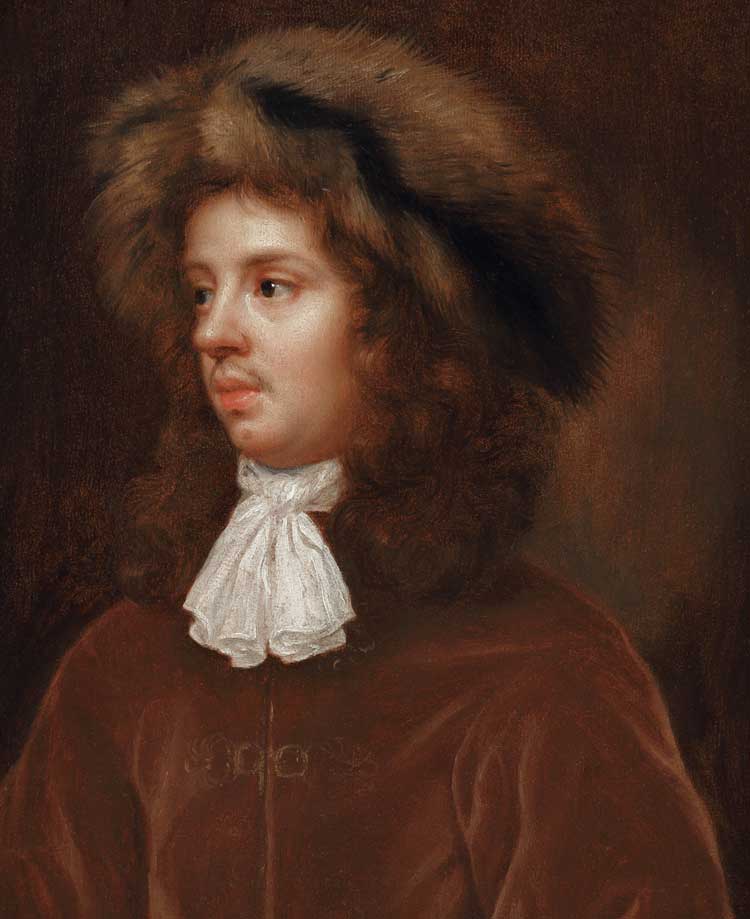
Mary Beale. Charles Beale, late 1650s. Oil on paper, laid on panel, 12 ½ × 10 ¼ in (31.8 × 26 cm). Philip Mould & Company.
As further mentioned in Vertue’s description of Beale’s almanacks, Bartholomew and Charles Jnr (the artist’s sons) were paid to help out in the studio. Their tasks included the painting of drapery and of backgrounds. Sotheby’s swathes of ultramarine dress, for example, were, technical analysis has shown, painted by Charles Jnr. The boys are also known to have painted the decorative oval cartouches of a carved stonework design for Portrait of a Gentleman (1670s), Charles Beale (c1680) and the pendant pair of William and Elizabeth Trumbull (1677). This trompe l’oeil trope, which gives the impression of the sitter gazing at the viewer through a window, developed as a means formalising bust-length portraiture and became a popular device used throughout the baroque period. Beale employed it so frequently that it became associated with her vernacular style and, in some instances, portraits were misattributed to her on the grounds of the presence of this decorative device.10
The popularity of Beale’s portraits lay, in good part, in her ability to capture accurate likenesses. The contemporary demand for this was expressed by the Lord Protector Oliver Cromwell to Lely in 1654: “Mr Lilly [sic] I desire you would use all your skill to paint my picture truly like me & not flatter me at all but remark all these ruffness, pimples, warts and everything as you see me … otherwise I will never pay a farthing for it.”11 Beale certainly did not flatter her sitters: her husband’s and son Charles’s warts are in evidence in her portraits of them, and double chins are also a common feature, as, for example, in Portrait of a Young Man, Thought to be Bartholomew Beale (1670s).
This portrait is also a good example of Beale’s painting of hands, which was something she took a great interest in perfecting. To this end, she produced plaster casts of various gestures from which to study. Charles documented a visit from Lely in January 1676/77: “We showed him also some of the hands we had cast in Alibaster especially in any of those of my Dearest Hearts in various positions which are cast up to ye elbow & he was very pleased with them and would hardly believe we could cast them so curiously ourselves.”12
In spite of – or more likely because of – her aesthetic honesty, the list of “people of Quality”, politicians, nobility and aristocracy, influential women and the occasional conspirator who sat for Beale has been described as a Who’s Who of late-17th-century London.13
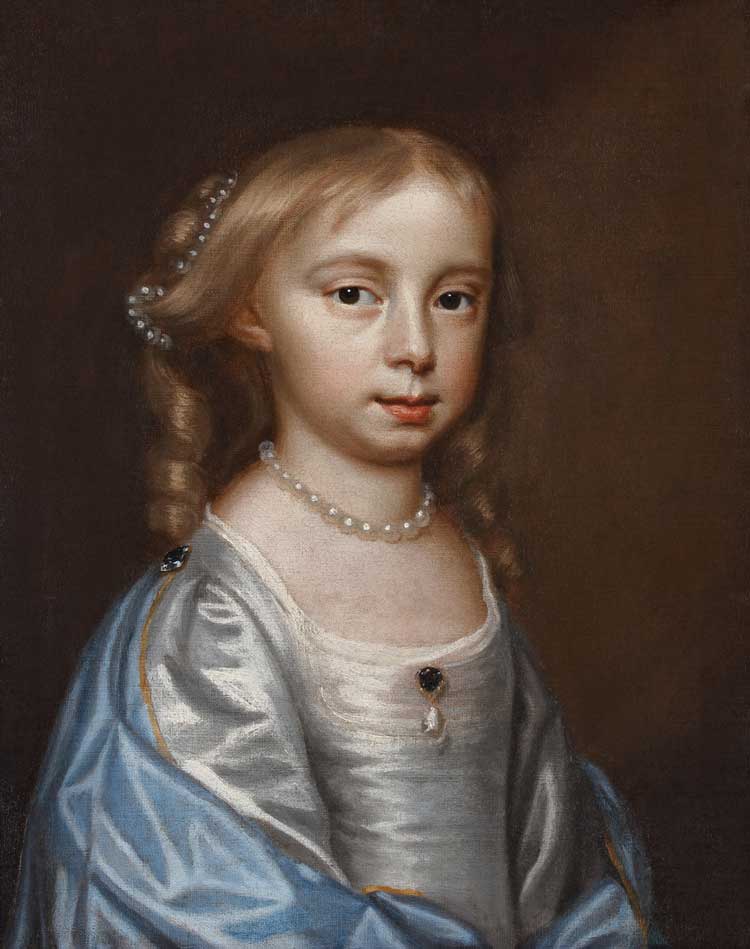
Mary Beale. Elizabeth Jones (c1664-81), early 1670s. Oil on canvas, 18 x 14 ¾ in (56 x 38 cm). Philip Mould & Company.
Another area in which Beale specialised and excelled was the portraiture of children. While parents wanted an artist to capture their offsprings’ delicate features and fresher skin tones, they equally demanded a level of formality which quite often led to depictions of stunted adults.14 In this exhibition, visitors can enjoy Beale’s youthful Portrait of a Young Boy (1680s) and Portrait of a Young Girl (c1680), as well as that of Elizabeth Jones (early 1670s) – one of the first works Beale made after moving to her Pall Mall studio – in which she captures an inner glow and, despite the formal dress, hairdo and pose, a certain impish quality. There are also plentiful pictures of her own sons. There are thought to be about 12 surviving sketched portraits of Bartholomew, of which Bartholomew Beale (early 1660s) is a good example. Painted in oil on paper, later laid on canvas (paper was a lot cheaper), it is sensitive and maternal. The boy looks upwards, with a sense of aspiration – or perhaps just simply gazing up at his mother. Five further studies are included in the accompanying catalogue.
Beale’s self-portraits were almost always paired with pendant images of her husband, reflecting the collaborative nature of their partnership. In 1666, Mary Beale wrote a treatise, Discourse on Friendship, as a letter to a female friend, in which she argued for the equality of men and women in marriage. She wrote: “This being the perfection of friendship that it supposes its professors equall, laying aside all distance, & so leveling the ground, that neither hath therein the advantage of other.”15 Charles, in turn, was clearly besotted, and frequently refers to Mary as “My Dearest Heart”. As early as July 1651, he recognised her artistic talent in a love letter, in which he mentioned “her best arts Master peece”.16
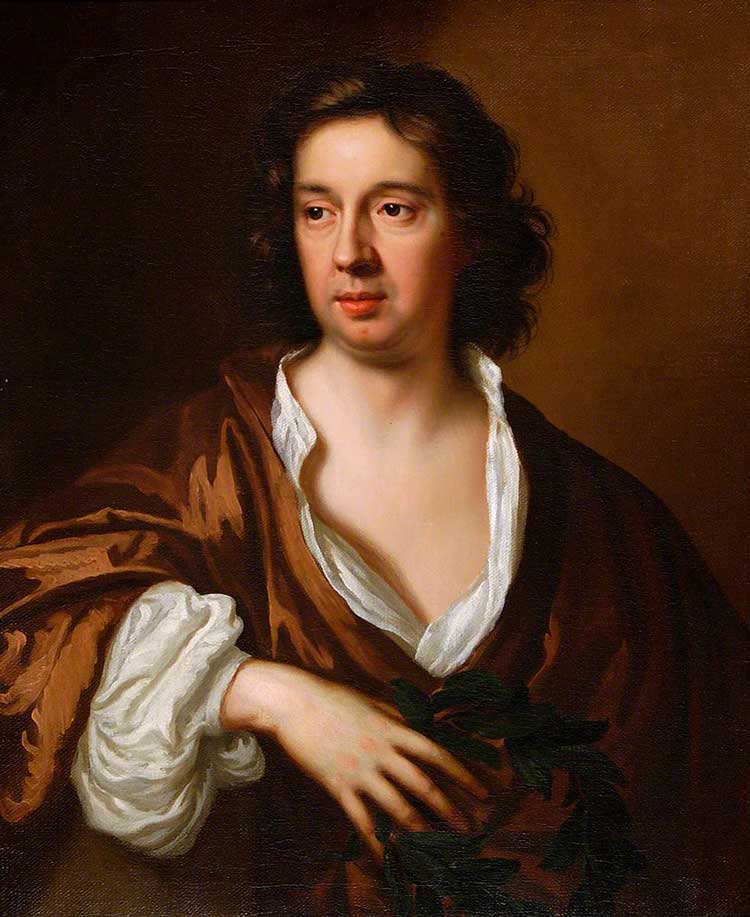
Mary Beale. Charles Beale, 1680s. West Suffolk Heritage Service.
Academic evaluation of Beale’s talent began as early as 1706 – just seven years after her death – with Bainbrigg Buckeridge’s Essay Towards an English School of Painters. He wrote that Beale “work’d with a wonderful Body of Colours, was exceedingly Industrious and her Pictures are much after the Italian Manner, which she learnt by having copy’d several of the Great masters of that Country, whose pictures she borrowed out of Sir Peter’s Collection”.17 A further means by which Beale practised was through her self-portraits and portraits of her family, which she continued to make, even when she was busy with professional commissions. Usually painted on bed ticking or onion sacking (cheaper alternatives to canvas), they are experimental in nature, demonstrating what Charles termed “study and improvement”.
Beale was incredibly prolific, producing 300 portraits between 1672 and 1681.18 At the height of her career, she worked a six-day week to fulfil all the demands for her pictures, and, alongside her sons, took on a couple of female pupils. It is said that, at one point, there were 74 wet canvases in the Beales’s Pall Mall flat. Her studio was within their family home, which would have aided the maintenance of a virtuous reputation with male collectors and sitters making studio visits, and, by a most delightful coincidence, recent research strongly suggests that this building was on the site where Philip Mould & Co now stands. It therefore seems entirely appropriate for this first proper solo exhibition of Beale’s work (there was a “display”, Mary Beale: Experimental Secrets, at Dulwich Picture Gallery, where she is the only historic female painter in the collection, in 2023) to take place here. Beale died at home in 1699 and is buried beneath the communion table at St James’s Church, Piccadilly – a stone’s throw away – where she is memorialised by a plaque, paid for by Mould in 1999 to mark the 300th anniversary of her death, replacing the one that was destroyed by bombing during the second world war.
As Beale specialist and Tate curator Tabitha Barber concludes in her essay for the exhibition catalogue, Beale was not only an extremely successful professional artist, but her influence and legacy extend into women’s history more generally: “[Beale] is discussed in the context of professional women active in other trades and as an urban businesswoman; she is relevant to debates as to what constitutes women’s private and public or vocational and professional activity; and she has a place in feminist literature, arguing as she did for male and female equality through friendship.”19 I don’t think this will be the last we hear (or see) of this remarkable woman.
References
1. Now You See Us: Women Artists in Britain (1520-1920), exhibition catalogue, Tate Britain, London, 2024, page 36.
2. Fruit of Friendship. Portraits by Mary Beale, exhibition catalogue, Philip Mould & Co, London, 2024, page 68.
3. My Dearest Heart. The Artist Mary Beale by Penelope Hunting, published by Unicorn, London, 2019, page 37.
4. Ibid, page 104.
5. Fruit of Friendship, op cit, page 50.
6. Ibid, page 15.
7. Hunting, op cit, page 141.
8. Ibid, page 105.
9. Ibid.
10. Fruit of Friendship, op cit, page 124.
11. Hunting, op cit, page 112.
12. Fruit of Friendship, op cit, page 94.
13. Hunting, op cit, page 122.
14. Fruit of Friendship, op cit, page 132.
15. Ibid, page 64.
16. Hunting, op cit, page 43.
17. Ibid, page 8.
18. Fruit of Friendship, op cit, page 49.
19. Ibid, page 26.